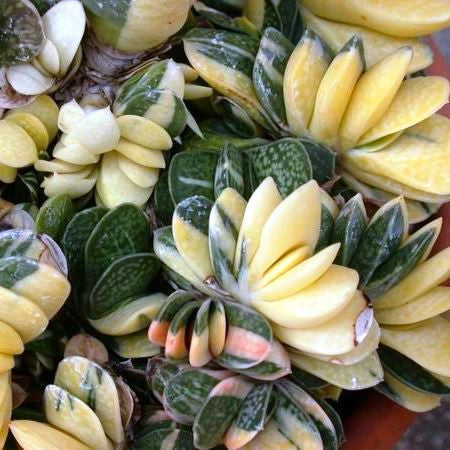Gasteria minima variegata
Family
Aloaceae
Origin
Eastern Cape, South Africa
Description
Gasteataria gracilis f. variegata has very dwarf clustering stacks of yellow striped fat pillowy leaves pushing out to eventually from fabulous hemispheres of many heads of bowtie plantlets.They are small, shallow-rooted, and relatively slow-growing. Gasteria are often grown in small clusters in wide, shallow dishes. Over time, clusters will naturally enlarge as the mother plant sends off .
Rosettes are 5-7 cm in diameter; stemless with basal leaves. The leaves are fleshy, fat, pillowy, tongue-like. Smooth, shiny, green speckled, wide with white dots and variably striped with yellow 3-5 cm long and 1 to 2,5 cm. wide. Leaves may turn red if plant is stressed.
Flowers are small up to 2 cm, pendulous, tubular, bicoloured reddish-pink and green that look like little stomachs. The inflorescence can be branched and tall.
Environment
Gasterias are popular undemanding indoor succulent plants, tolerating a little shade and infrequent watering. However, some sun ensures a compact growth habit, attractive leaf coloration in some species and abundant flowers
These decorative little plants can be grown in interesting containers such as tea cups and even miniature baby shoes. Make sure the container had adequate drainage. If it doesn t, it might be a good idea to pop the plant out of its container and add a layer of gravel to the bottom to reduce the wicking action of the soil above.
Propogation
Gasteria is easily propagated by the removal of offshoots or by leaf cuttings in spring or summer. To propagate by leaf cuttings, remove a leaf and let it lie for about one month, giving the wound time to heal. Then lay the leaf on its side with the basal part buried in the soil. This leaf should root within a month or two, and small plants will form at the leaf base. They can also grown from seed.
Landscape Use
Suitable for Container, Rock Garden & Xeriscaping


















